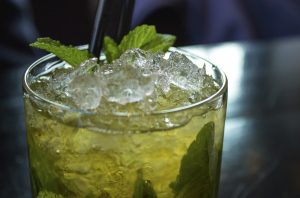
Whether “on the rocks,” mixed in a mojito, or poured over a cake, rum remains a popular and versatile drink. It is the third most popular distilled spirit in the United States, behind vodka and whiskey. In recent years, rum distillers have been adding flavorings such as coconut, citrus, and spices to their product. In 2019, for the holidays, Captain Morgan introduced gingerbread spiced rum to its product lineup. Currently, flavored and spiced rum accounts for more than 55% of rum sold in the United States.
Rum is an alcoholic beverage made from molasses, a byproduct of sugar refining.1 It was first distilled in the early 17th century in the West Indies. Due to trade, the popularity of this drink spread to the British colonies of North America. The first distillery in the colonies opened in 1664 on Staten Island, New York. Soon after, colonial New England became a distilling center. Distilleries in Massachusetts and Rhode Island provided up to three-quarters of the rum for export. By the middle of the 18th-century, 93 distilleries in these two states were producing about 1.2 million gallons per year.
Rum figured prominently in the trade between the North American British colonies, Africa, and the West Indies. Slaves were brought from Africa to the West Indies and traded for molasses. The molasses would be made into rum in colonial New England distilleries, then exported to Africa to trade for more slaves.
Distilleries in Connecticut, New York, and Pennsylvania mostly supplied the domestic market. By the Revolutionary War, the consumption of rum in the colonies was estimated to be three imperial gallons for every man, woman, and child.
Today’s market size shows the total U.S. rum supplier gross revenues for 2008 and 2018. Overall sales have been trending downward since 2013 when sales reached its highest in at least a decade and a half, 25.6 million 9-liter cases. In 2018, 23.9 million cases were sold, a 1.51% drop from the 24.24 million cases sold in 2008, and a 6.6% drop from 2013 levels. Gross revenues increased by 5.41% from 2008 to 2018 but trended downward 3.93% from 2013 to 2018. While value and premium types of rum have seen their sales decrease, high-end premium and super premium sales increased from 2008 to 2018. High-end premium sales increased by 21.21%, with revenues increasing by 24.11%. Sales of 9-liter cases of super premium rum increased by nearly 250% during this time period, its revenues increasing 258%. Currently, there are 194 rum distillers in the United States producing more than 400 brands. Bacardi was the top brand in 2018, selling 6.49 million 9-liter cases in the United States. Worldwide, the top five brands by 2018 sales volume include Tanduay (20.1 million 9-liter cases), Bacardi (17.1 million), Captain Morgan (11.7 million), McDowell’s No. 1 Celebration (11.2 million) and Havana Club (4.6 million).
Geographic reference: United States
Year: 2008 and 2018
Market size: $2.18 billion and $2.3 billion, respectively
Sources: “Rum: More Than Just Piña Coladas…,” Distilled Spirits Council, February 2019 available online here; “Rum,” Wikipedia, November 25, 2019 available online here; “Rum,” Encyclopedia Britannica available online here; Kyle Swartz, “Captain Morgan Rolls Out Gingerbread Spiced Rum,” Beverage Dynamics, November 21, 2019 available online here; Thomas Henry Strenk, “Rum’s Conundrum,” StateWays, May 31, 2018 available online here; “American Rum Producers,” Rob’s Rum Guide available onlne here; “Colonial Molasses Trade,” Wikipedia, March 31, 2019 available online here; Jan Conway, “Rum Industry – Statistics & Facts,” Statista, August 6, 2018 available online here; Jan Conway, “Sales Volume of the United States Spirits Industry from 2010 to 2018, by Category,” Statista, February 19, 2019 available online here; Jan Conway, “Leading Rum Brands Worldwide in 2018, Based on Sales Volume (in Million 9 Liter Cases)*,” Statista, July 8, 2019 available online here; Jan Conway, “Volume Sales of the Leading Rum Brands in the U.S. 2018,” Statista, August 5, 2019 available online here.
Image source: Paul Steuber, “cocktail-mojito-drink-alcoholic-2306939,” PIxabay, May 12, 2017 available online here.
